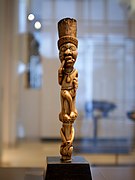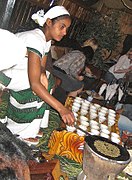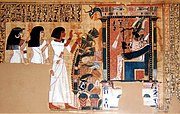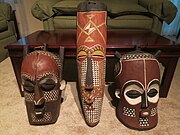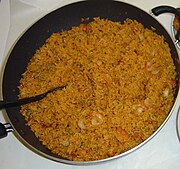Portal:Pan-Africanism/Selected culture/1
The culture of Africa is varied and manifold, consisting of a mixture of countries with various tribes that each have their own unique characteristic from the continent of Africa. It is a product of the diverse populations that today inhabit the continent of Africa and the African Diaspora. African culture is expressed in its arts and crafts, folklore and religion, clothing, cuisine, music and languages. Expressions of culture are abundant within Africa, with large amounts of cultural diversity being found not only across different countries but also within single countries. Even though African cultures are widely diverse, it is also, when closely studied, seen to have many similarities. For example, the morals they uphold, their love and respect for their culture as well as the strong respect they hold for the aged and the important i.e. Kings and Chiefs.
Africa has influenced and been influenced by other continents. This can be portrayed in the willingness to adapt to the ever-changing modern world rather than staying rooted to their static culture. The Westernized few, persuaded by European culture and Christianity, first denied African traditional culture, but with the increase of African nationalism, a cultural recovery occurred. The governments of most African nations encourage national dance and music groups, museums, and to a lower degree, artists and writers.
-
Kenyan boys and girls performing a traditional folklore dance.
-
Sudanese basket tray, Tabar of weaved natural plant fibre, coloured in different colours.
-
A Yombe sculpture (Louvre, Paris).
-
Ashanti Kente cloth patterns.
-
An Ethiopian woman preparing Ethiopian coffee at a traditional ceremony. She roasts, crushes and brews the coffee on the spot.
-
BaKongo voodoo masks from the Kongo Central region.
-
Jollof rice, originally from the Senegambia region (Senegal and the Gambia), is a very popular dish.
-
The mbot mask symbolising Ndut classical teachings in Serer religion.
-
Nsibidi symbols of Nigeria.
-
An early-20th-century Yoruba divination board



